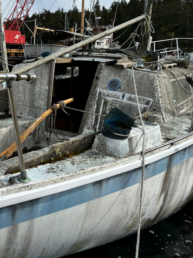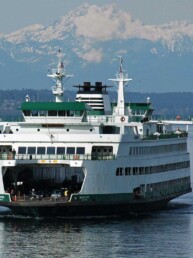As April fools day approaches, my mind always strays to the regional tall tales locals like to spin: Scotland’s Loch Ness monster, our Pacific Northwest Bigfoot, and the rumored alligator of my own cruising grounds, the Columbia River near Portland. (Alas, that one turned out to be a nicely painted deadhead on the shallow end of Government Island.)

Until recently, I’d assumed that the floating Port-a-Potty on the Columbia was just as likely a story as the gator. After all, I’d never seen it; and don’t all sailors like to spin yarns, especially after a few brews?
I first heard about the aquatic comfort station from a fisherman who swore it was in the works near Government Island, although a hang-up with environmental permits had delayed the project for years. (Apparently predatory fish might use its shade to ambush protected salmon smolts.) Another friend assured me that the river restroom was real, though he’d never seen it himself. I was skeptical. Despite overnighting on the island, racing on the main channel, and rowing along the shore, I had never noticed it.
One hot day last summer, I decided to circumnavigate Government Island without a motor. I had made it two thirds of the way when the wind died near the northeast corner of the island, a place I seldom visit. As I sat in the boat, waiting for a breeze to fill in, I noticed a strange metallic craft in the distance. Was it a shantyboat, or perhaps a dock? As I rowed in for a closer look, a big sign on the side started to materialize. “Public Restroom.”
Leapin’ latrines! It wasn’t a myth, after all!

I rowed closer to take a gander. The restroom, a neat rectangular metal structure comprising two chambers, sat on an aluminum barge that I later learned was about 24 feet long, 12 feet wide, and four feet deep. I looped my mooring lines around some conveniently placed horn cleats and peered gingerly in the door.
The first thing to strike me was the surprising lack of odor. And it was clean, too. More toilet than head, the facility lacks a pumping mechanism (as well as the familiar sign admonishing users not to put too much TP down the hole).
Later, still curious, I phoned the Oregon State Marine Board and talked with Ashley Massey, who explained that the good people at Oregon State Parks partner with the board, conducting all the maintenance, which includes cleaning, adding water for flushing, and towing the barge, which can hold more than 1,000 gallons of waste, to shore to be pumped out.

While the restrooms are a priceless service to the hundreds of boaters who use them each season, the cost of constructing these double-walled barges runs close to $150,000. However, thanks to a partnership with Oregon Department of Fish and Wildlife, Oregon State Parks, and Clean Vessel Act funds, the cost to the state was considerably less. “It seems like a lot, but when you think of all they do,” Ashley noted, “they pay for themselves with clean water benefits.”
Her colleague Jenny East, SeaGrant’s Boat Outreach Coordinator, also affectionately known as the “Porta Potty Queen,” was enthusiastic about a topic some might consider unsavory. She shows up at boating events to promote the restroom program. “People initially think that I’m selling them,” she said, noting that there are more than 20 floating restrooms in Oregon waters, including some in salt water, “right within view of Highway 101 in Tillamook Bay.”
I doubt I’ll ever encounter Nessie or Big Foot, but the next time someone mentions the floating restroom, I’ll be happy to confirm that it’s more than a tall tale. The Porta Potty Party Barge is the real deal.
Bruce Bateau
Bruce Bateau sails and rows traditional boats with a modern twist in Portland, Ore. His stories and adventures can be found at www.terrapintales.wordpress.com






